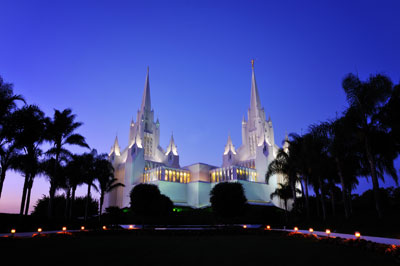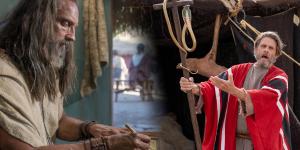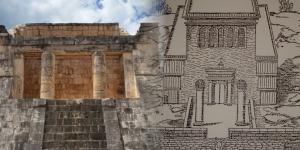You are here
What Makes 3 Nephi the Holy of Holies of the Book of Mormon?

3 Nephi 14:13-14
The Know
At the pinnacle of the history recorded in the Book of Mormon readers find in 3 Nephi the story of the resurrected Jesus Christ who descended from heaven to teach the people at the temple in Bountiful. The magnitude and sacred content of 3 Nephi 11–26 has brought BYU Professor John W. Welch to call it the “holy of holies” of the Book of Mormon.1
A careful analysis of the text reveals that it can be seen as a literary counterpart to the physical holy of holies of the ancient temple. The book depicts a temple setting where Jesus Christ descended from heaven to the temple in the Nephite city of Bountiful (see 3 Nephi 11). With the people gathered around, Christ taught them from that sacred edifice. His words were replete with temple-related terms and imagery, although these are not often noticed. Jesus both opened and closed His initial sermon speaking about building upon the rock, “evoking images of the temple and its eternal stability.”2
At the temple, Jesus taught a version of the Sermon on the Mount, a set of teachings that contains many subtle references to the temple. Welch explained how the Sermon on the Mount (and 3 Nephi’s “Sermon at the Temple”) presents principles in a way that can be seen as an escalating path of ascent, leading adherents towards heaven.3
Welch noted how the sermon begins on a mountain (compare the “mountain of the Lord’s house,” Isaiah 2:2) and ends by talking metaphorically “about the wise man who builds upon that mountain, by not only hearing but actually patterning his house of righteousness after God’s holy house.”
The culmination of the sermon is marked by the pronouncement of the words enter, an invitation to enter the kingdom of God, or, otherwise, depart (3 Nephi 14:21–23).4 The ultimate entrance requirement is found in the instruction, “Not everyone that saith unto me, Lord, Lord, shall enter into the kingdom of heaven; but he that doeth the will of my Father who is in heaven” (3 Nephi 14:21). Regarding the significance of this final principle, Welch commented:
If entrance into the presence of God is the end to which the Sermon on the Mount and the Sermon at the Temple both lead, readers should consider the profound connections between the heart of 3 Nephi and the inner sanctum of the temple.5
With this perspective in mind, one can make a comparison between the holy of holies of the ancient temple and the events recounted in the book of 3 Nephi. The following table represents a selection of relevant elements.6
| Element | Holy of Holies | 3 Nephi |
|---|---|---|
| Presence of God | The Lord would appear there (Leviticus 16:2) | Jesus appeared to the people at the temple (11:8–12) |
| Word of the Lord | God’s word comes forth from his presence in the first person (Leviticus 26; Psalm 17:2; Isaiah 6:1) | Jesus spoke face to face in the first person to the people gathered at the temple (11:9–10) |
| High Priesthood | Only anointed high priests had access to Holy of Holies | Jesus ordained his disciples to higher priesthood (18:37; Moroni 2:1–3) |
| Covenant | Resting place of the ark of the covenant containing Ten Commandments | Jesus taught about the Ten Commandments and caused people to participate in covenants (18:10) |
| Shewbread | Priests ate the showbread, which represented manna, the bread from heaven | Christ gave disciples the sacrament, representing his body “shown” unto them (18:7) |
| The Divine Name | High Priest wore the name of the Lord on his forehead when he went in to the Holy of Holies (Exodus 28:36; cf. Numbers 6:27) | People took upon themselves the name of Christ when they partook of the sacrament (18:11; Moroni 4:3) |
| Purity | Participants needed to have “clean hands and a pure heart” (Psalm 24:3–4) | Jesus emphasized the need for purity/worthiness when participating in sacred ordinances (18:28–29) |
| Blessing | High Priest offered the priestly blessing (Numbers 6:24–26) | Jesus blessed the multitude and fulfilled the words of the priestly blessing (19:25) |
| White Garments | The High Priest wore white linen garments on the Day of Atonement (Leviticus 16:4) | Jesus wore exceedingly white garments (19:25) |
| Angels | Cherubim represented angels of the Lord’s presence; Isaiah saw fiery seraphim (Isaiah 6:2, 6; cf. Psalm 104:4) | Angels appeared multiple times, “encircled about as if it were by fire” (19:14; 17:24; 27:30) |
The Why
Although the scriptural passages regarding the temple and the work of the high priest in the Old Testament can be somewhat obscure and are symbolic of future realities, the account of Christ’s appearance at the temple in 3 Nephi is a living manifestation of those ancient symbols. Studying the Sermon at the Temple (or the Sermon on the Mount) from this perspective can give one a greater appreciation for the Sermon and also for the temple, both ancient and modern.
Many readers may not notice how much the Book of Mormon teaches about the temple and how central the temple, its precepts and ordinances are to the book’s message. In the words of Professor Welch:
One of [the Book of Mormon’s] precepts is clearly the centrality of the temple. The book of 3 Nephi lays forth a holy template for how one may dwell forever in the house of the Lord Jesus Christ, the Son of God and the great and eternal High Priest of all mankind.7
Reflecting his own attitude toward 3 Nephi, Welch explained, “When I go to the temple, I think of that as being my trip this month or week to Bountiful; what I experience at the temple is my opportunity to come as close as I can to what happened in 3 Nephi.”8
For Latter-day Saints, going to the temple is a sacred experience; it offers an opportunity to step out of the world and into the presence of divinity. In ancient Israel, the Holy of Holies was a sacred space—so sacred that only the high priest was permitted to enter—where the Lord dwelt. The sacred record in 3 Nephi invites all people to come unto Christ and be perfected in Him: “Therefore I would that ye should be perfect even as I, or your Father who is in heaven is perfect” (3 Nephi 12:48). Seeing 3 Nephi this way can help all people to envision coming into the holy presence of God.
When 3 Nephi is seen as the holy of holies, reading it becomes an opportunity for readers to disengage the world and to consecrate their lives to loving and serving the true and living God. We learn from its pages: “For where your treasure is, there will your heart be also. . . . No man can serve two masters; . . . Ye cannot serve God and Mammon. . . . Seek ye first the kingdom of God and his righteousness, and all these things shall be added unto you” (3 Nephi 13:21, 24, 33).
Further Reading
John W. Welch, “Seeing Third Nephi as the Holy of Holies of the Book of Mormon,” Journal of the Book of Mormon and Other Restoration Scripture 19/1 (2010): 36–55; also published in Third Nephi: An Incomparable Scripture, ed. Andrew C. Skinner and Gaye Strathearn (Salt Lake City and Provo, UT: Deseret Book and Neal A. Maxwell Institute for Religious Scholarship, 2012), 1–33.
John W. Welch, The Sermon on the Mount in Light of the Temple (Burlington, VT: Ashgate, 2009).
John W. Welch, Illuminating the Sermon at the Temple and the Sermon on the Mount (Provo, UT: FARMS, 1999).
Margaret Barker, The Gate of Heaven: The History and Symbolism of the Temple in Jerusalem (London: SPCK, 1991).
- 1. John W. Welch, “Seeing Third Nephi as the Holy of Holies of the Book of Mormon,” Journal of the Book of Mormon and Other Restoration Scripture 19, no. 1 (2010): 36–55; also published in Third Nephi: An Incomparable Scripture, ed. Andrew C. Skinner and Gaye Strathearn (Salt Lake City and Provo, UT: Deseret Book and Neal A. Maxwell Institute for Religious Scholarship, 2012), 1–33.
- 2. Welch, “Seeing Third Nephi,” 40–41. The passages mentioned are 3 Nephi 11:38–39 (“this is my doctrine, and whoso buildeth upon this buildeth upon my rock”) and 3 Nephi 14:24–27 (“I will liken him unto a wise man, who built his house upon a rock”). The image of “the rock” is an ancient symbol associated with both the Lord and the Temple (see, e.g., Psalm 94:22; 71:3; Isaiah 25:4; 28:16; 2 Chronicles 3:1).
- 3. John W. Welch, The Sermon on the Mount in Light of the Temple (Burlington, VT: Ashgate, 2009).
- 4. See Welch, “Seeing Third Nephi,” 45. See also Book of Mormon Central, “Why Did Jesus Say that Some Well-Intended People Would Be Told to Depart? (3 Nephi 14:21),” KnoWhy 205 (October 10, 2016).
- 5. Welch, “Seeing Third Nephi,” 45.
- 6. See Welch, “Seeing Third Nephi,” 45–52, for a more complete list.
- 7. Welch, “Seeing Third Nephi,” 53.
- 8. John W. Welch in “3 Nephi Conference Panel Discussion,” in Third Nephi, 381.
KnoWhy Citation
Related KnoWhys
Subscribe
Get the latest updates on Book of Mormon topics and research for free







